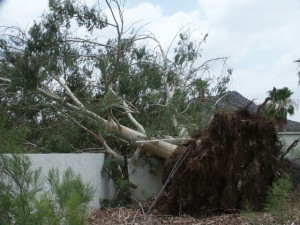Prepare Your Trees for Summer Part 4
Rain and Wind Dynamics

Wind forces act upon trees in unique ways depending on the distribution of foliage throughout the entire tree crown as well as along individual branches. Thinning cuts as well as reduction cuts help reduce the drag (wind resistance) on the tree canopy and lower the height of the pressure center to larger diameter wood. To prepare your trees for summer winds, a combination of both types of pruning is needed but especially reduction pruning. Research has shown that reduction pruning to alleviate end weight is the best type of pruning to decrease risk of tree and branch failure.
A big mistake is to over-thin trees with the idea that this makes them safer. There is an unacceptable pruning technique called Lion’s Tailing that removes an excessive number of smaller branches from a tree’s interior at the neglect of the outer third of the crown. You’ve probably seen these sorry, stripped-out specimens on your street. The wind blows through their lower crown but is concentrated now in the lion tails of heavy foliage that flag in the wind and often break. Properly thinned branches have an even distribution of foliage along the entire length of the branch. Consequently the force of the wind is now evenly distributed along the length of the branch, transferring that force to the base of the branch where the diameter is greater and it can better support the branch movement.
Tips to prepare your trees for summer storms:
- Plant trees in groups. They buffer the wind from their neighbor trees.
- Turn off your water! Excessive irrigation prior to a wind event can lead to entire tree failure. So turn off your watering system when a major monsoon storm is coming.
- Don’t Lion Tail your trees.
- Concentrate pruning in the outer third of the canopy using primarily reduction pruning techniques. Proper reduction pruning requires special skill to avoid making heading or stub cuts. If your trees are large or have excessive end weight, consider hiring a Certified Arborist to help out.
If you prune your own trees, consider attending one of my upcoming pruning classes. I will be teaching a class at the Desert Botanical Garden on June 22nd. Click here for more information or to register.


